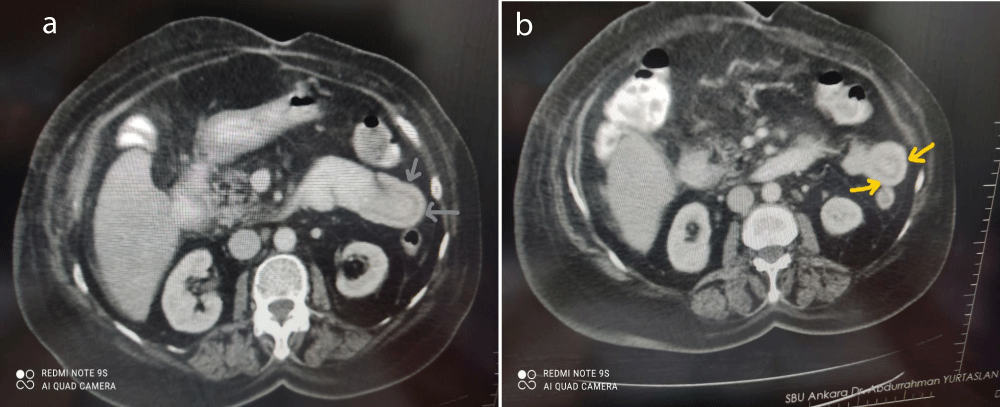More Information
Submitted: November 16, 2022 | Approved: November 23, 2022 | Published: November 24, 2022
How to cite this article: Aydin H, Özdemir Y, Törenek S. An Incidental finding: Duodeno-jejunal transient invagination. Arch Surg Clin Res. 2022; 6: 016-016.
DOI: 10.29328/journal.ascr.1001065
Copyright License: © Aydin H, et al. This is an open access article distributed under the Creative Commons Attribution License, which permits unrestricted use, distribution, and reproduction in any medium, provided the original work is properly cited.
An Incidental finding: Duodeno-jejunal transient invagination
Hasan Aydin*, Yasin Özdemir and Şahap Törenek
Radiology Department, Ankara Oncology Education and Research Hospital, Turkey
*Address for Correspondence: Dr. Hasan Aydin, Radiology Department, Ankara Oncology Education and Research Hospital, Turkey, Email: [email protected]
Invagination or intussusception is the protrusion of proximal intestinal segments through the distal segments, Transient Intussusception can be easily diagnosed by Abdominal CT.
In this report, an incidentally found ‘’Duodeno-jejunal Invagination’’ tilted case, was presented with CT images.
Invagination or intussusception is the protrusion of proximal intestinal segments through the distal segments, Transient Intussuception can occur both in children and adults, and can easily be diagnosed by Abdominal CT [1].
In this report, an incidentally found ‘Duodeno-jejunal Invagination’ case was presented with CT images.
70 years old woman with HT and DM anamnesis, was admitted to an emergency by chief complaints of abdominal pain, nausea, and vomiting. After a physical examination and laboratory analysis, she was referred to our Radiology department for AbdominoPelvic CT in order to exclude any suspicious malignancy.
In axial contrast-enhanced CT images; a 6 cm long intestinal segment from the 4th part of the duodenum, was protruded into the proximal jejunal segments and pathognomonic target and sausage signs of invagination were also visualized (Figure 1a,1b).
In the endoscopic exploration after 2 weeks, post-bulbar gastritis was diagnosed without any signs of intussusception.
Figure 1: a: Characteristic sausage sign of intussuception in the axial contrast-enhanced Abdominal CT, shown by gray arrows. b: Pathognomonic target sign of invagination belonging to the jejunal lenses in the Abdominal CT, represented by yellow arrows.
Transient intussusceptions were generally idiopathic and self-limited, and might occur due to some metabolic disorders such as Coeliac disease, non-neoplastic conditions such as lymphoid hyperplasia, infections, and due to neoplastic formations like lymphoma, carcinoid tumor, primary adenocarcinoma or metastatic diseases such as melanoma [1-3].
Transient intussusceptions generally didn’t require any surgical approaches [2]. CT was the gold standard in the exact diagnosis of invagination [1-3].
- Guillén Paredes MP, Campillo Soto A, Martín Lorenzo JG, Torralba Martínez JA, Mengual Ballester M, Cases Baldó MJ, Aguayo Albasini JL. Adult intussusception - 14 case reports and their outcomes. Rev Esp Enferm Dig. 2010 Jan;102(1):32-40. English, Spanish. doi: 10.4321/s1130-01082010000100005. PMID: 20187682.
- Manekar AA, Janjala N, Sahoo SK, Tripathy BB, Mohanty MK. Recurrent intussusception as a rare clinical manifestation of intestinal malrotation in children—a case report and review of the literature. Ann Pediatr Surg. 2021; 17: 46. https://doi.org/10.1186/s43159-021-00115-6
- Lai J, Ramai D, Murphy T, Kasher F. Transient Adult Jejunojejunal Intussusception: A Case of Conservative Management vs. Surgery. Gastroenterology Res. 2017 Dec;10(6):369-371. doi: 10.14740/gr881w. Epub 2018 Jan 3. PMID: 29317946; PMCID: PMC5755640.
